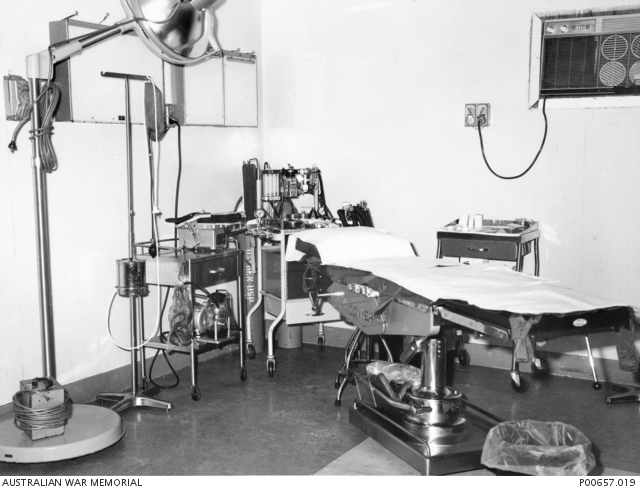
1 minute read
From the Archives
by RANZCR
Recent Acquisitions: Highlighting the Importance of Radiology During the Vietnam War
We all have varying reactions when commemorative days like ANZAC Day or Remembrance Day come into the forefront of our minds and public culture. For some of us, it recalls the sacrifices those who came before us made, and who some continue to pay through ongoing illnesses or disabilities.
Radiology has always played an important role in war. The First World War was one of the first real tests of the ‘new’ technology of x-rays. Army medical professionals had to become experts while dealing with the sheer number of incoming patients with time sensitive injuries, and due to their efforts, lives were saved.
Recently, The Trainor/Owen Collection has received a donation from the 1st (Aust) Field Hospital Association
Incorporated. The donated book, Call Sign Vampire, highlights the stories from an Australian Field Hospital during the Vietnam War located in Vung Tau. The hospital was in operation from April 1968 until November 1971.
BACKGROUND
From 1962 to 1973, approximately 60,000 Australians served in Vietnam. More than 500 lost their lives, with a further 3,000 wounded, injured or victims of illness and therefore requiring hospitalisation. The Vietnam War was Australia’s longest 20th century conflict involving active participation.
In Australia, all young men aged 20 were required to register with the Department of Labor and National Service. Their names were then selected using the ‘Birthday Ballot.’ This forced selective conscription based on birth dates was used to draft 63,740 young men into the army. Combined with ongoing televised footage of live combat and daily news articles detailing injuries or death, general dissatisfaction grew. The Vietnam War quickly became widely seen as a war not for Australia’s involvement. Nation-wide protests began and many resisted being drafted. This also, unfortunately, resulted in soldiers meeting a hostile reception on their return home.
The fallout from the war onto Vietnam and the surrounding areas, such as Cambodia and Laos can not be ignored. Civilians lost their lives, and millions became refugees as a direct effect of the War. Chemicals used during the war, such as Agent Orange, have caused long-lasting negative effects on the region and many still experience symptoms today.
By many accounts, The Vietnam War was a social and political disaster.
RADIOLOGY AND ITS ROLE IN VIETNAM
Initially, Australian troops received medical care from the US naval hospital in Saigon, or by US army hospitals. Due to the building up of forces, notably due to the conscripted forces coming in, the First Australian Field Hospital was established in 1967.
Casualties that required operation were processed through the triage and underwent three major processes: Resuscitation, blood cross matching and x-ray procedures. X-ray was the only investigative tool available to medical professionals. In the quarter ending June 1969, 997 patients were x-rayed and on average needed 2 films per patient. X-rays were used on inpatients and outpatients as well as to determine cause of death for some diggers. A heavy portable x-ray machine was used and as Rob Lennox, the in-house radiographer, recalls "All film processing was performed manually. The resultant x-rays were ‘far from perfect’." (1) At this point, no radiologist had been stationed at the hospital. Films that the clinicians could not interpret were referred to the US Radiologist based nearby.
In March of 1970, Colonel Charles Stuart, a notable Australian radiologist and co-editor of The Proceedings of the College of Radiologists of Australasia (later known as Australasian Radiology) volunteered for service. His subsequent report was the first by a qualified radiologist working in a field unit overseas to have appeared in the fifty years since World War Two. Notable inclusions in his report include a detailed itinerary of the x-ray equipment, immediate needs, and types of battle casualties.
NOT JUST SOLDIERS
The hospital and medical staff were not just catering to and caring for the Australian soldiers. Locals, including children, Taiwanese fisherman, Embassy Staff, Allied civilians and Viet Cong soldiers also entered the hospital as patients. Care was provided for all.
By late 1970, due to ongoing pressure, Australian troops began to withdraw. Australia’s involvement in the Vietnam War formally came to an end on January 11th, 1973.
Despite the war ending, Australia’s medical support did not. Under the Colombo Plan, between 1970-1975 a primary-care radiology service called techamatic radiology was field tested in Vietnam. It involved providing radiologists from the Medical Education Project and radiographers to support Vietnamese radiologists and nine machines which produced simple, good quality plain film of chest, abdomen, limbs, skull and spine. The training provided varied from a few days to several weeks, depending on the experience of the trainee. The training courses came to an end in 1975 due to the fall of the South Vietnamese Government.
I believe this speaks to the ‘higher cause’ medical clinicians answer to. Despite the surrounds of conflict, medical care was provided. In the fallout of war, an attempt was made to provide training to those who required it.
The Trainor Trust thanks the 1st (Aust) Field Hospital Association Incorporated for their donation and their efforts in bringing to light the stories from the Australian Field Hospital during the Vietnam War.
If you have any queries or wish to donate to the Trainor Owen Collection, please contact the College Archivist.
Natasha Ramrakha archives@ranzcr.edu.au
Was I fighting an enemy? ...You are there to heal and if the enemy came in, he’d get the same treatment... No, I didn’t have an enemy." ~ Brian Cornish (Searle et al., 2021. p139)

1. Searle et al., 2021.p116






